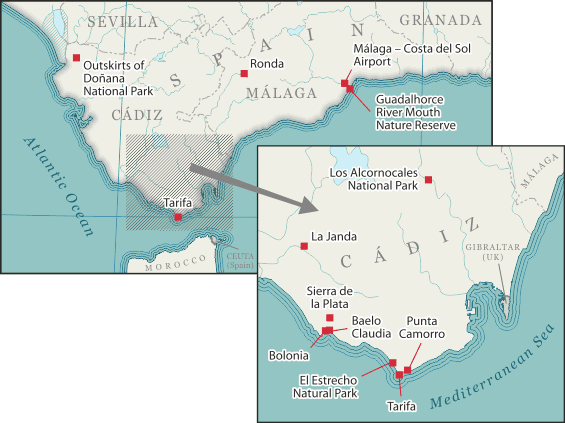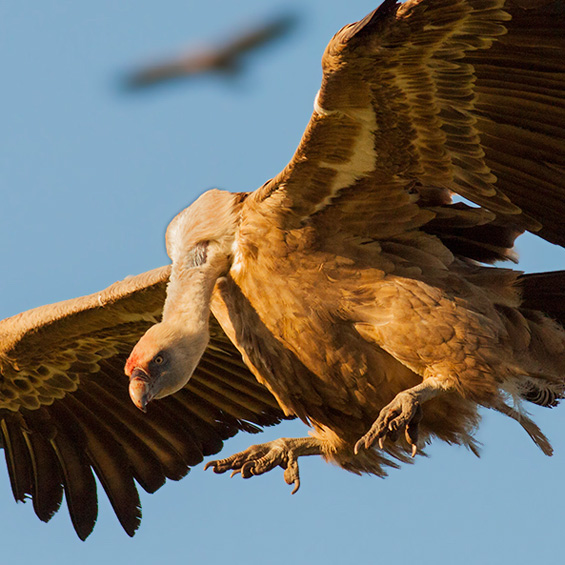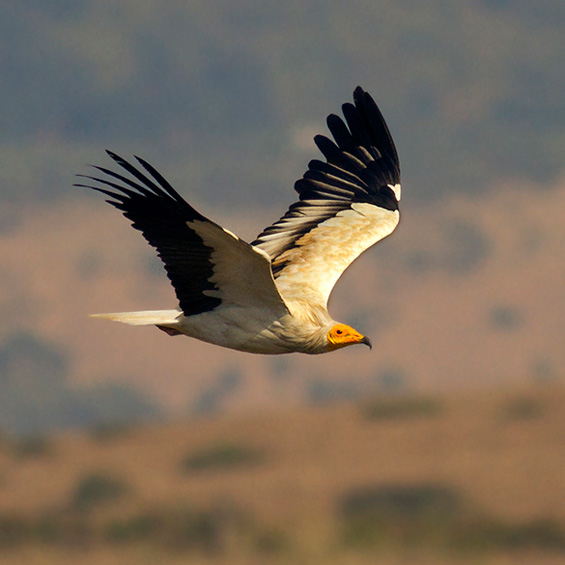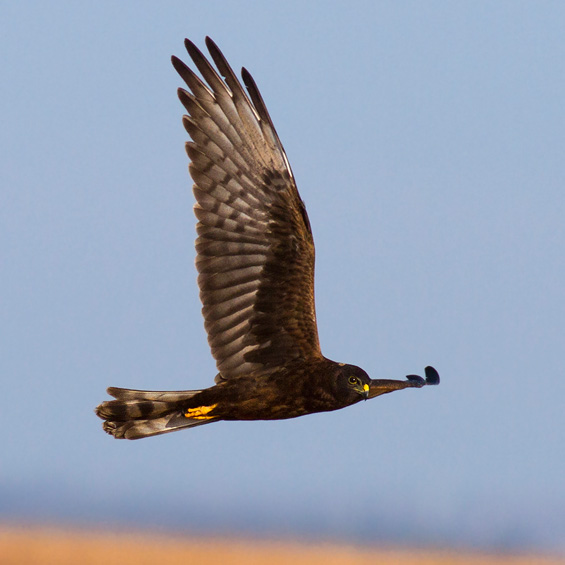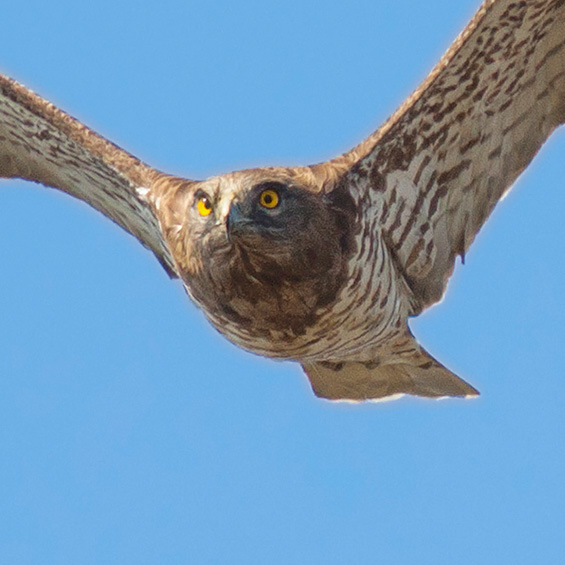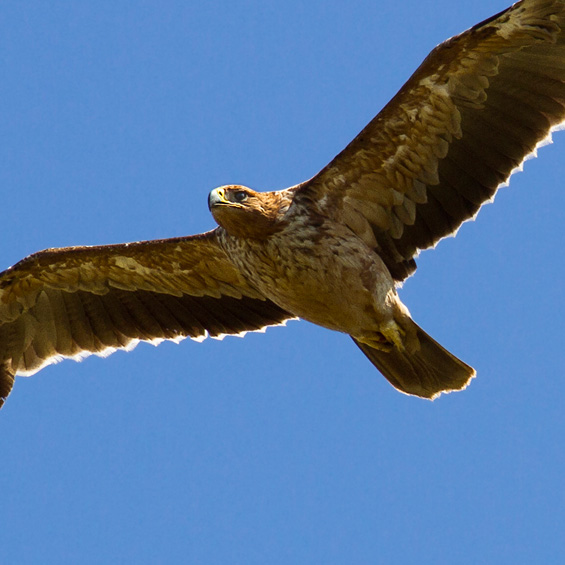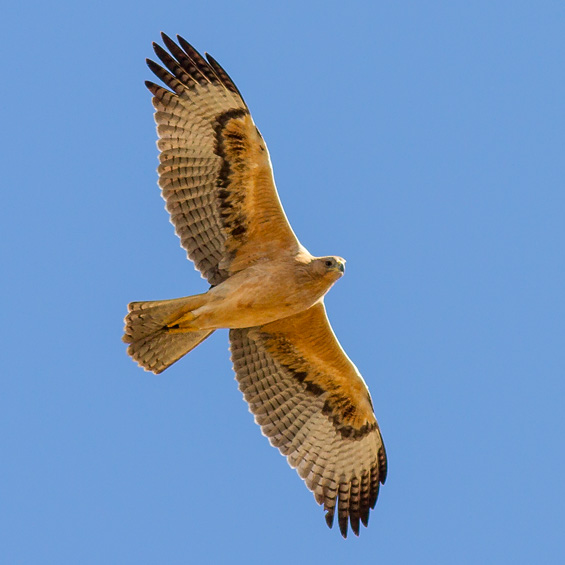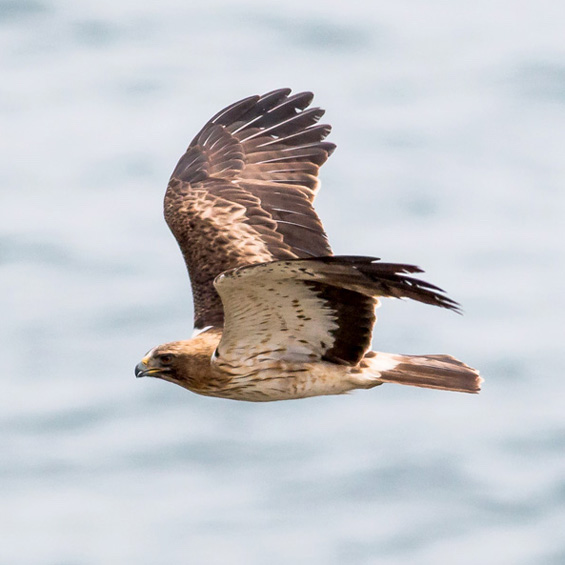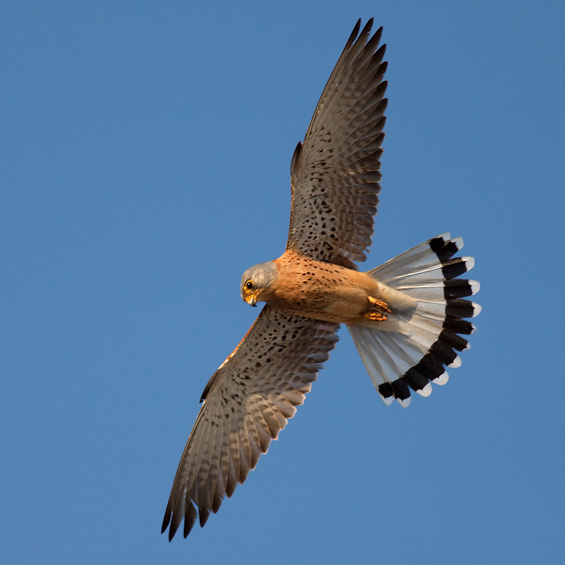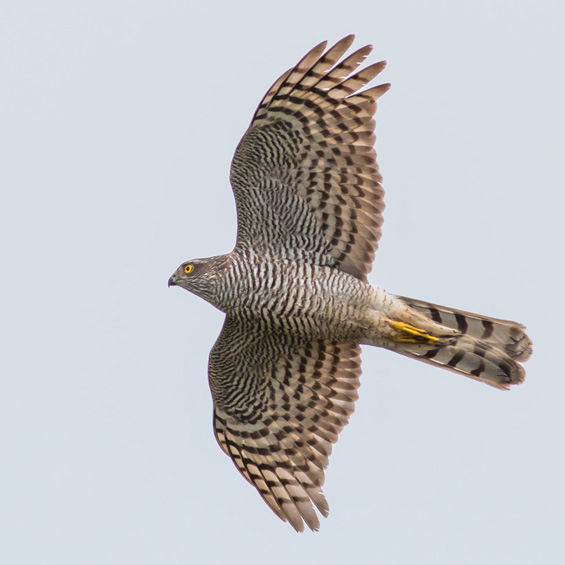Strait of Gibraltar Raptor Tour
Strait of Gibraltar Raptor Tour
Share this!
Great birds well-seen, first-class food and accommodations. Highlights included the mating dance of tumbling Lesser Kestrels, hundreds of migrating Short-toed Snake Eagles, and the Spanish Imperial Eagle family. As a first-time visitor to Spain, I thrilled to see these birds in action in this atmospheric country.”
Elaine Radford, USA. 2014 Edition
The Strait of Gibraltar is one of the best spring raptor-watching destinations in the Old World. Impressive numbers of raptors crossing the Strait, returning from Africa onto Europe to breed, need to overcome the 9-mile long water crossing. As thermal currents develop only weakly over water, soaring raptors lose altitude as they progress across the Strait. By the time they reach the European shores they can be flapping a few feet above the waves. As a result of this, a larger proportion of birds are seen flying lower, even below eye-level, and a lot closer than in autumn affording great looks and photo ops.
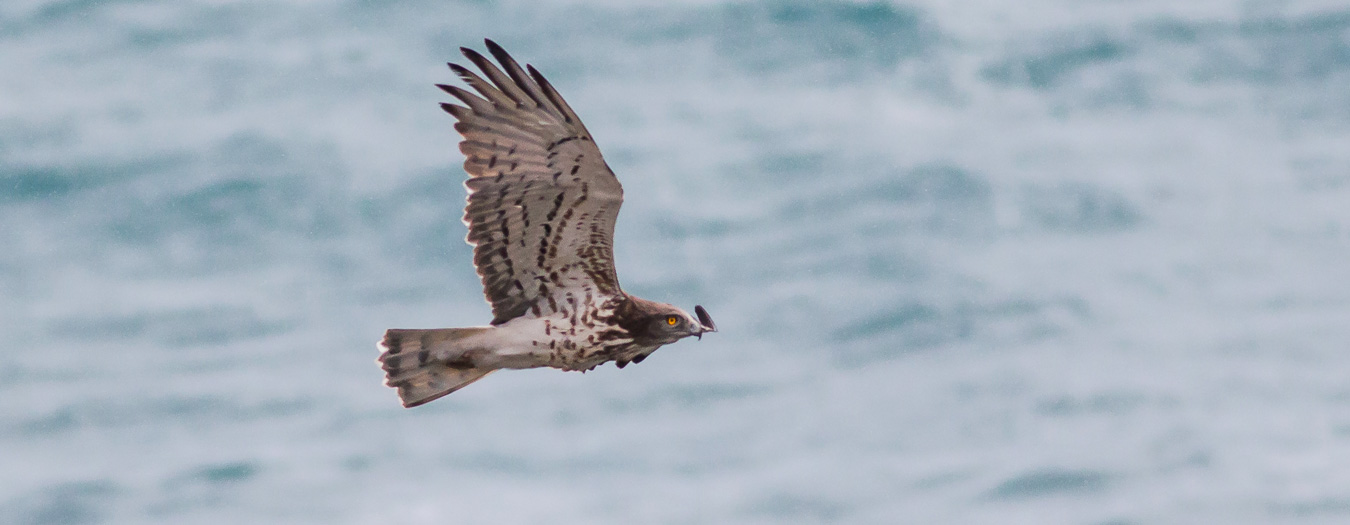
Migrant raptors such as this Short-toed Snake Eagle reach the European shores flapping a few feet above the waves.
While spring time numbers are smaller than in autumn they are still remarkable. Over the last decade, spring season-long counts averaged around 80,000 Black Kites, 10,000 Booted-Eagles, and 12,000 Short-toed Snake Eagles, to mention the most numerous species migrating through the area. Other raptors on migration during this period, although in smaller numbers, include Egyptian Vulture (EN), Griffon Vulture, Eurasian Sparrowhawk, Montagu’s and Marsh Harriers, Osprey, Lesser Kestrel and Eurasian Hobby.
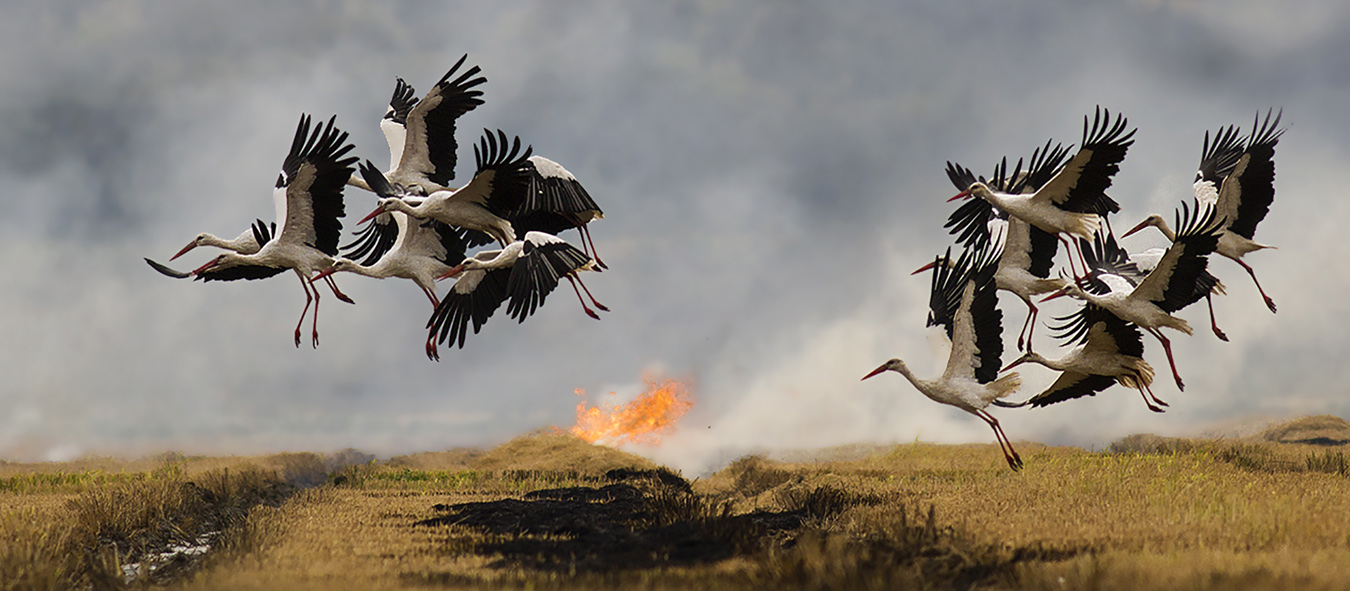
In addition to watching the raptor migration, we will explore the former lagoon of La Janda, searching for other resident raptors such as the Spanish Imperial Eagle (VU), Bonelli’s Eagle and Black-winged Kite.
Great General Birdwatching Too
Black and White Storks on migration are also a delight to watch, and spring time is also a good time to do it. We will visit the breeding colony of the recently reintroduced and Globally Threatened Northern Bald Ibis, and the only colony of Little Swifts in Europe, a recent colonizer from Africa. A visit to the outskirts of Doñana National Park, in Cádiz should render White-headed Ducks, Marbled Teals and large numbers of waders and flamingos.
NEW Special Feature: Bearded Vultures!
We will target the charismatic and most impressive king of the sierras of northern Andalusia: the Bearded Vulture! We will explore the beautiful Parque Natural de las Sierras de Cazorla, Segura y Las Villas looking for Bearded Vultures, Golden Eagles, Northern Goshawks, and Peregrine Falcons, among other charismatic fauna, including the Iberian Ibex.
Main Tour
Day-by-Day Itinerary
The Strait of Gibraltar is a mere 9 miles across at its narrowest point. This crossing, however, can be quite challenging, or even lethal to raptors and other birds migrating through the area. As it turns out, strong easterly winds, locally known as levante, can potentially blow birds out into the Atlantic, which many drown as a result of this. On the other hand, strong westerly winds, poniente, have a similar effect but birds end up in the Mediterranean. Under normal conditions, winds can blow steadily for a few days in a row, which usually result in a rather poor migratory flights. But once winds stop, or diminish in intensity, the conditions emerge for a big push across the Strait, and thousands, or even tens of thousands of raptors and other birds can be observed in a single, or a few days. Therefore, the flight path of migrating birds can shift from day to day. To account for this, we will rely on constant contact with official counters and other birders in the area to adjust our daily strategy to make the best of our time in the Strait.
The following itinerary is to give you an idea of the alternative sites we will visit, rather than laying out a rigid plan. We will adapt to prevailing wind and weather conditions, and the resulting flight behavior of the migrating hawks, and will rely on local knowledge and constant communication with official migration counters to maximize our chances of a great Strait of Gibraltar experience.
Day 1
11 March
Arrival in Malaga-Costa del Sol Airport (IATA code AGP) and transfer to the Hotel Plaza del Castillo. Around 3 pm, we will visit the Guadalhorce River Mouth Nature Reserve, as an introduction to the Mediterranean avifauna. We can expect Greater Flamingo, White-headed Duck, Black-winged Stilt, Kentish Plover, Whiskered Tern, European Bee-eater, Iberian Yellow Wagtail, Spotless Starling, Crested Lark, Red-rumped Swallow, Sardinian Warbler, Zitting Cisticola, Cetti´s Warbler, Serin, the exotic Ring-necked Parakeet, and the first Booted Eagles of the trip! 6.00 pm, get back to our hotel and relax. 7.00 pm, join afternoon arrivals at dinner. Overnight at the Hotel Plaza del Castillo.
Day 2
12 March
7.30 am, breakfast. 8.30 am, check-out. This morning we will drive to Tarifa, our base to explore the birds of the Strait of Gibraltar and its cultural riches for the next few days. We expect to arrive there in 2-3 hs depending on traffic. The sight of the Rock of Gibraltar will announce our imminent arrival in the area. We will head directly to some of the best raptor migration observatories upon arrival, eat a picnic lunch there, and enjoy the flight. Short-toed Snake Eagle, and Booted Eagle, Black Kite, Marsh, and Montagu’s Harriers, Egyptian Vulture (EN), and Eurasian Sparrowhawk, are to be expected. In the afternoon, we will visit the El Estrecho Natural Park. Here we will look for Audouin’s and Mediterranean Gulls, Kentish Plovers and Terns. Indeed, this is probably the most reliable site to find Lesser-crested Terns on migration from the Mediterranean population breeding in Libya. The surrounding pastures are excellent for an array of passerines including Zitting Cisticola, Tawny Pipit, large flocks of Corn Buntings and the Iberian race of the Yellow Wagtail. 6.00 pm, check-in at the Meson de Sancho. 8.00 pm, dinner at the hotel. Overnight at the Meson de Sancho.
Day 3
13 March
7.30 am, breakfast. This morning we will visit the hawk-watch in Punta Camorro. This place is one of the best raptor migration lookouts in the Strait of Gibraltar. Then, we will spend some time observing raptor migration from a nearby coastal hawkwatch, with good chances to observe seabirds including Cory´s and Balearic Shearwaters too. Lunch. In the afternoon, we will visit the Bolonia and Sierra de La Plata area, within El Estrecho Natural Park, which offers one of the most beautiful scenic views of the Strait of Gibraltar. From there you’ll see the African coast, sand dunes, cliffs and the ancient Roman city of Baelo Claudia—a real highlight. Cliffs in this area hold a large Griffon Vulture colony, and nesting sites of the endangered Egyptian Vulture (EN). Vagrant in southern Spain, and typically an African raptor, the critically endangered Ruppell’s Griffon (CR) is regularly seen here too. Griffon Vultures will be fully engaged in chick-rearing and will offer spectacular views. This is also an excellent place to observe the Blue Rock Trush, Cirl Bunting, Black-eared Wheatear and Thekla Lark. Depending on wind direction, Bolonia area can be an excellent raptor migration spot. 6.30 pm, back at the hotel to relax. 8.00 pm, dinner at the hotel restaurant. Overnight at the Meson de Sancho.
Day 4
14 March
7.30 am, breakfast at the hotel. Today we will explore La Janda and its surroundings, north of Tarifa, looking for some of the most interesting species in the region. Our first stop will be in agricultural lands where Montagu’s Harriers breed. Then, we will drive through one of the best preserved coastal areas in Spain, to the Barbate Marshes. Here, noisy flocks of Collared Pratincoles are very showy and Stone-Curlews hide in the islets of the former salt plants. Black-winged Stilt, Pied Avocet, Common Redshank and Greater Flamingo occur here as well. The next stop will take us to the striking Northern Bald Ibis breeding colony. After a successful reintroduction project, this critically endangered species is breeding again in the Strait of Gibraltar, holding over 22 pairs and 90 individuals in 2017. This is a unique chance to observe and photograph one of the rarest bird species on Earth. Lunch. We will devote the afternoon explore La Janda. This former lagoon, now turned into agricultural land, combines large communities of passerines, waterbirds, and raptors! Marsh Harrier, Black-winged Kite, Black Kite, Booted Eagle and Short-toed Snake Eagle forage here. Moreover, this is one of the best places in Spain to observe the rare Bonelli’s Eagle, and the near-endemic Spanish Imperial Eagle (VU). Hundreds of Cattle Egrets hang their nests in the riparian vegetation where a few Glossy Ibises breed as well. Purple Swamphen and Great Reed Warbler can be observed in the reedbeds. Calandra Larks are abundant in the fields and Little Owls are often active in daytime. With a bit of luck, we will have the chance to observe an Eagle Owl at its day roost. 6.30 pm, back at the hotel to relax. 8.00 pm, dinner at the hotel restaurant. Overnight at the Meson de Sancho.
Day 5
15 March
Today we will focus on the Spanish Imperial Eagle (VU). Endemic to the Iberian Peninsula, the Spanish Imperial Eagle is one of the most emblematic birds in Europe. Nearly extinct in the 1960s, its population is currently recovering thanks to conservation efforts. We will explore different breeding territories and foraging areas in search of adult and immature birds. This will be an excellent opportunity to learn more on the ecology and management of this iconic species. We will also visit Los Alcornocales Natural Park, often regarded the Mediterranean Jungle. This is the largest Cork Oak Forest in the continent and an excellent site to look for forest species, including Iberian Chiffchaff, Firecrest, and the elusive Northern Goshawk. The bark of the oaks is harvested in a traditional fashion to make wine cork. Dinner and overnight at the Meson de Sancho.
Day 6
16 March
Today we will depart early from the Hotel, as we will visit the Outskirts of Doñana National Park in Cádiz (1:45 hours’ drive from Tarifa), East of Guadalquivir River. This is one of the least visited and most rewarding birding areas in Doñana. A mosaic of fish farming and salt work facilities, along with lagoons, vineyards and pastures, creates a diverse wetland. Large numbers of flamingos, waders (ca. 20 species), egrets and herons will be present in the area, along with Slender-billed Gulls, Little and Caspian Terns and Purple Swamphens. Lesser Short-toed Larks are easily spotted here as well. Our main targets will be the White-headed Duck and the Marbled Teal, which often provide good views in the pools. Despite being away from the Strait, we will have many chances to observe migrating raptors in this region, including Osprey. In the afternoon, and before heading back to Tarifa, we will visit the the only breeding colony of Little Swifts in Europe. Dinner and overnight in Meson de Sancho.
Day 7
17 March
7.30 am, breakfast. Then head out for another exciting day of raptor migration watching in the Strait. We will follow local advise depending on wind direction and intensity and will hit the hawk-watches with best chance of offering a good flight. The focus will be on completing our raptor list and enjoying the migration. Picnic lunch at a hawkwatch. Afternoon trip to Algerciras (25 min drive) to get tested for Covid-19, if this requirement for boarding return flights is still in place at the time the tour is conducted. 6.30 pm, back at the hotel and relax. 8.00 pm, dinner. Overnight at the Meson de Sancho.
Day 8
18 March
7.30 am, breakfast and check-out. Today we will head inland, to the mountains of Cádiz and Málaga provinces, a radically different landscape. The limestone environments offer beautiful scenery where we will have the chance to observe Black Wheatears and Rock Sparrows. Griffon Vultures are widespread here, and we will have the chance to observe both Bonelli’s, and Golden Eagles. We will drive through several Pueblos Blancos (white villages), which are typical in this region of Spain. We will overnight in Ronda, one of the most charming historical cities of the country, and considered to be home of modern bullfighting. This is also the home of the Spanish Ibex. The city is on a mountain range approximately 750 m a. s. l., where Crag Martin, Alpine Swift and Red-billed Chough are widespread. Peregrine Falcons of the Mediterranean brookei subspecies breed here. Check in at the hotel. Dinner and overnight at the hotel Hotel Maestranza.
Day 9
19 March
7.30 am, breakfast and check-out. Drive to Cazorlas. We will visit El Chorro lookout, an emblematic area located in the Natural Park of Cazorla, Segura and Las Villas which holds a pair of Peregrine Falcons and where we will have our first chance to spot the Bearded Vulture. This impressive raptor was reintroduced in this area and is now breeding in some cliffs of the nature reserve. At the end of the day, we will head to Burunchel, where we will eat dinner and spend the night in the charming Hotel Curro de la Sierra de Cazorla. Night in Burunchel.
Day 10
20 March
Today we’ll visit Sierra Cazorla Natural Park, Segura and Las Villas looking for raptors with a special emphasis on the Bearded Vulture. Other raptorial highlights today may include Golden Eagle, Goshawk, and Peregrine Falcon. Other non-raptor species possible in the nature reserve are Red-billed Chough, Crested Tit and Short-toed Treecreeper, among others. Dinner and overnight in our hotel in Burunchel.
Day 11
21 March
After breakfast and some easy birding around our hotel, we will head south to find the nature reserve of the Fuente de Piedra lagoon. It's an emblematic site where we will look for Black-winged Kite, Western Marsh Harrier, and Lesser Kestrels. The lagoon also holds the largest breeding population of Greater Flamingo of the Iberian Peninsula. We will spend the last night in the charming Hotel Los Dolmenes de Antequera.
Day 12
22 March
In the morning we’ll visit the El Torcal de Antequera where limestone outcrops are inhabited by some remarkable wildlife, including the Spanish Ibex. We will also look for the Black Wheatear, and we will have another chance to look for the regional subspecies of Golden Eagle. Then we will go to Málaga Airport where we will end the trip.
Target Species
Common Name
- Osprey (LC)
- Black-winged Kite (LC)
- Bearded Vulture (NT)
- Egyptian Vulture (EN)
- Griffon Vulture (LC)
- Cinereous Vulture (NT)
- Short-toed Snake Eagle (LC)
- Booted Eagle (LC)
- Spanish Imperial Eagle (VU)
- Golden Eagle (LC)
- Bonelli’s Eagle (LC)
- Eurasian Sparrowhawk (LC)
- Northern Goshawk (LC)
- Western Marsh Harrier (LC)
- Hen Harrier (LC)
- Montagu's Harrier (LC)
- Black Kite (LC)
- Long-legged Buzzard (LC)
- Common Buzzard (LC)
- Lesser Kestrel (LC)
- Common Kestrel (LC)
- Eurasian Hobby (LC)
- Peregrine Falcon (LC)
Latin Name
- Pandion haliaetus
- Elanus caeruleus
- Gypaetus barbatus
- Neophron percnopterus
- Gyps fulvus
- Aegypius monachus
- Circaetus gallicus
- Hieraetus pennatus
- Aquila adalberti
- Aquila chrysaetos
- Aquila fasciata
- Accipiter nisus
- Accipiter gentilis
- Circus aeruginosus
- Circus cyaneus
- Circus pygargus
- Milvus migrans
- Buteo rufinus
- Buteo buteo
- Falco naumanni
- Falco tinnunculus
- Falco subbuteo
- Falco peregrinus
Suggested Field Guides
Clark, W.S. 1999. A Field Guide to the Raptors of Europe, the Middle East, and North Africa. Oxford U. Press, Oxford.
Forsman, D. 1999. The Raptors of Europe and the Middle East: A Handbook of Field Identification. T&D Poyser, London.
Forsman, D. 2016. Flight Identification of Raptors of Europe, North Africa and the Middle East. Christopher Helm, London.
NEED TO KNOW
TOUR DATES & AVAILABILITY
11-22 March 2024
AVAILABILTY
12 Places
GROUP SIZE LIMITS
2-12 Participants
All-Inclusive TOUR PRICE
Tour price is US$5,490 and includes hotels (double occupancy), all meals with non-alcoholic drinks, ground transportation, and guide fees.
International flights, alcoholic beverages, entrance visa (if applicable), extra nights in Spain, items of personal nature, tips, and insurance of any kind are not included.
A non-refundable Registration Fee of US$490 will be requested at the time of booking. This fee counts against the total tour price.
Single supplement is US$400.
Roommates will be assigned to those participants willing to share a room. If a roommate is not available, you will be required to pay the single supplement.
BOOKING & PAYMENT
Use the ‘Book This Tour’ button above to fill out the online booking form at your earliest convenience. Participants will be accepted on a first come, first served basis. This online form is contractual.
Once your application information is reviewed, and your application approved, the non-refundable Registration Fee will be requested (credit cards via PayPal only).
Once we have reached the minimum number of participants (2) the remaining balance, plus any applicable Single Supplement fees will be requested. Wire transfer is the preferred method of payment. Credit card payments are also accepted but a US$150 handling fee applies.
TRIP CANCELLATIONS
All cancellation requests must be made in writing to Raptours, L.L.C.
Cancellations requested before 1 January 2024 will be subject to a full refund minus the non-refundable reservation fee (US$490).
No refunds will be made for cancelations requested on 1 January 2024 or after.
Raptours, L.L.C. reserves the right to cancel the tour at any time with full refund to participants (including the Reservation Fee).
Travel cancellation insurance is recommended.
COUNTRY ENTRY REQUIREMENTS
U.S. citizens may enter Spain for up to 90 days for tourist or business purposes without a visa. Your passport should be valid for at least three months beyond the period of stay. You need sufficient funds and a return airline ticket.
DIFFICULTY
Easy. No strenuous walks or hikes involved.
COMFORT
Good to Very Good. Guide-to-participant ratio 1:4 or better
Accommodations throughout will be comfortable, AC, and private bathrooms. Free wi-fi, either in rooms or public areas, will be available.
We will travel in comfortable vans with AC. No long drives are involved.
WEATHER & CLOTHING
Temperatures will range from an average high of 64 °F (18 °C), to chilly lows of 55 °F (13 °C) during night time. We expect 20% probability of rain on any given day there.
March is the windiest month of the year in the Strait with an average of 12 m/h (20 km/h), but windspeed can be considerably greater. Bring long-sleeved clothing, and at least one warm jacket, and a brim hat. Plan to wear layers. Sunscreen and sunglasses are recommended.
HEALTH
For detailed information on health precautions and vaccines recommended for Spain visit CDC’s website 6 weeks before departure.
LOCAL CURRENCY
Local currency is the euro. Credit cards are widely accepted throughout the tour locations.
TOUR REPORTS
Tour Leader

Tour Map
Tour Showcase
Terms
Raptours, L.L.C. reserves the right to alter this itinerary as necessary, or to cancel the tour prior to departure, with full refund to participants.
Raptours, L.L.C. or its agents may decline to accept or retain any person as a member of this tour at any time.
No smoking will be permitted while with the group, either when indoors or in the field.
Travel medical insurance is strongly recommended.
All passengers will be required to sign a hard copy of the Release of Liability and Assumption of Risk form upon meeting with the tour leader in Málaga.
No participants will be allowed in the group without a signed copy of the Release of Liability and Assumption of Risk form.
Release of Liability and Assumption of Risk Form
(including Terms)
![]()


